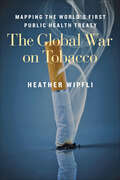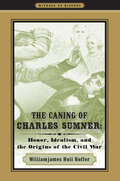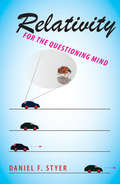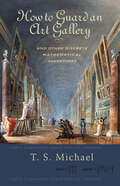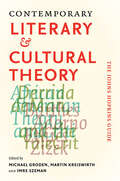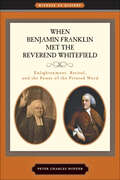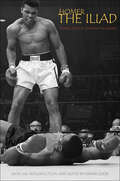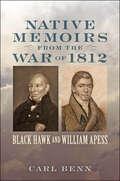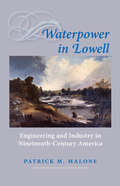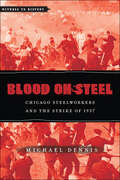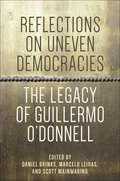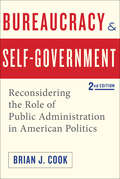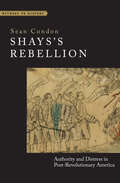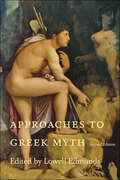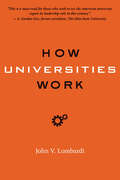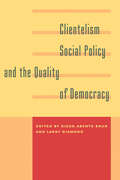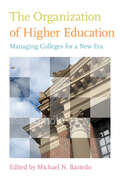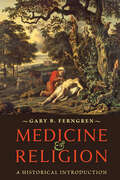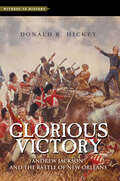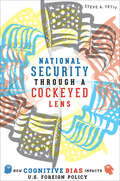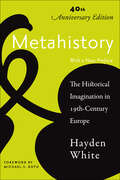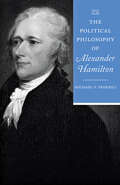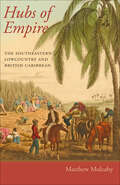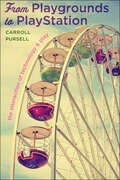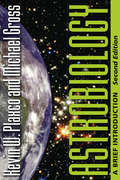- Table View
- List View
The Global War on Tobacco: Mapping the World's First Public Health Treaty
by Heather WipfliThe tobacco industry has capitalized on numerous elements of globalizationâ€�including trade liberalization, foreign direct investment, and global communicationsâ€�to expand into countries where effective tobacco control programs are not in place. As a consequence, tobacco is currently the leading cause of preventable death in the world. Each year, it kills more people than HIV, malaria, and tuberculosis combined. Amid evidence of an emerging pandemic, a committed group of public health professionals and institutions sought in the mid-1990s to challenge the tobacco industry’s expansion by negotiating a binding international law under the auspices of the World Health Organization. The WHO Framework Convention on Tobacco Control (FCTC)â€�the first collective global response to the causation of avoidable chronic diseaseâ€�was one of the most quickly ratified treaties in United Nations history. In The Global War on Tobacco, Heather Wipfli tells the engaging story of the FCTC, from its start as an unlikely civil society proposal to its enactment in 178 countries as of June 2014. Wipfli also reveals how globalization offers anti-tobacco advocates significant cooperative opportunities to share knowledge and address cross-border public health problems.The bookâ€�the first to delve deeply into the origin and development of the FCTCâ€�seeks to advance understanding of how non-state actors, transnational networks, and international institutionalization can impact global governance for health. Case studies from a variety of diverse high-, middle-, and low-income countries provide real-world examples of the success or failure of tobacco control. Aimed at public health professionals and students, The Global War on Tobacco is a fascinating look at how international relations is changing to respond to the modern global marketplace and protect human health.
The Caning of Charles Sumner: Honor, Idealism, and the Origins of the Civil War (Witness to History)
by Williamjames Hull HofferA signal, violent event in the history of the United States Congress, the caning of Charles Sumner on the Senate floor embodied the complex North-South cultural divide of the mid-nineteenth century. Williamjames Hull Hoffer's vivid account of the brutal act demonstrates just how far the sections had drifted apart and explains why the coming war was so difficult to avoid. Sumner, a noted abolitionist and gifted speaker, was seated at his Senate desk on May 22, 1856, when Democratic Congressman Preston S. Brooks approached, pulled out a gutta-percha walking stick, and struck him on the head. Brooks continued to beat the stunned Sumner, forcing him to the ground and repeatedly striking him even as the cane shattered. He then pursued the bloodied, staggering Republican senator up the Senate aisle until Sumner collapsed at the feet of Congressman Edwin B. Morgan. Colleagues of the two intervened only after Brooks appeared intent on beating the unconscious Sumner severely—and, perhaps, to death. Sumner's crime? Speaking passionately about the evils of slavery, which dishonored both the South and Brooks’s relative, Senator Andrew P. Butler. Celebrated in the South for the act, Brooks was fined only three hundred dollars, dying a year later of a throat infection. Sumner recovered and served out a distinguished Senate career until his death in 1873.Hoffer's narrative recounts the caning and its aftermath, explores the depths of the differences between free and slave states in 1856, and explains the workings of the Southern honor culture as opposed to Yankee idealism. Hoffer helps us understand why Brooks would take such great offense at a political speech and why he chose a cane—instead of dueling with pistols or swords—to meet his obligation under the South’s prevailing code of honor. He discusses why the courts meted out a comparatively light sentence. He addresses the importance of the event in the national crisis and shows why such actions are not quite as alien to today’s politics as they might at first seem.
Relativity for the Questioning Mind
by Daniel F. StyerTo those of us who are not mathematicians or physicists, Einstein’s theory of relativity often seems incomprehensible, exotic, and of little real-world use. None of this is true. Daniel F. Styer’s introduction to the topic not only shows us why these beliefs are mistaken but also shines a bright light on the subject so that any curious-minded person with an understanding of algebra and geometry can both grasp and apply the theory.Styer starts off slowly and proceeds carefully, explaining the concepts undergirding relativity in language comprehensible to nonscientists yet precise and accurate enough to satisfy the most demanding professional. He demonstrates how the theory applies to various real-life situations with easy equations and simple, clear diagrams. Styer's classroom-tested method of conveying the core ideas of relativity—the relationship among and between time, space, and motion and the behavior of light—encourages questions and shows the way to finding the answers. Each of the book’s four parts builds on the sections that come before, leading the reader by turn through an overview of foundational ideas such as frames of reference, revelatory examples of time dilation and its attendant principles, an example-based exploration of relativity, and explanations of how and why gravity and spacetime are linked. By demonstrating relativity with practical applications, Styer teaches us to truly understand and appreciate its importance, beauty, and usefulness.Featuring worked and end-of-chapter problems and illustrated, nontechnical explanations of core concepts, while dotted throughout with questions and answers, puzzles, and paradoxes, Relativity for the Questioning Mind is an enjoyable-to-read, complete, concise introduction to one of the most important scientific theories yet discovered. The appendixes provide helpful hints, basic answers to the sample problems, and materials to stimulate further exploration.
How to Guard an Art Gallery and Other Discrete Mathematical Adventures
by T.S. MichaelWhat is the maximum number of pizza slices one can get by making four straight cuts through a circular pizza? How does a computer determine the best set of pixels to represent a straight line on a computer screen? How many people at a minimum does it take to guard an art gallery?Discrete mathematics has the answer to these—and many other—questions of picking, choosing, and shuffling. T. S. Michael's gem of a book brings this vital but tough-to-teach subject to life using examples from real life and popular culture. Each chapter uses one problem—such as slicing a pizza—to detail key concepts about counting numbers and arranging finite sets. Michael takes a different perspective in tackling each of eight problems and explains them in differing degrees of generality, showing in the process how the same mathematical concepts appear in varied guises and contexts. In doing so, he imparts a broader understanding of the ideas underlying discrete mathematics and helps readers appreciate and understand mathematical thinking and discovery.This book explains the basic concepts of discrete mathematics and demonstrates how to apply them in largely nontechnical language. The explanations and formulas can be grasped with a basic understanding of linear equations.
Contemporary Literary and Cultural Theory: The Johns Hopkins Guide
by Imre Szeman Michael Groden Martin KreiswirthContemporary Literary and Cultural Theory: The Johns Hopkins Guide is a clear, accessible, and detailed overview of the most important thinkers and topics in the field. Written by specialists from across disciplines, its entries cover contemporary theory from Adorno to Žižek, providing an informative and reliable introduction to a vast, challenging area of inquiry. Materials include newly commissioned articles along with essays drawn from The Johns Hopkins Guide to Literary Theory and Criticism, known as the definitive resource for students and scholars of literary theory and for philosophical reflection on literature and culture.
When Benjamin Franklin Met the Reverend Whitefield: Enlightenment, Revival, and the Power of the Printed Word (Witness to History)
by Peter Charles HofferIn the 1740s, two quite different developments revolutionized Anglo-American life and thought—the Enlightenment and the Great Awakening. This book takes an encounter between the paragons of each movement—the printer and entrepreneur Benjamin Franklin and the British-born revivalist George Whitefield—as an opportunity to explore the meaning of the beginnings of modern science and rationality on one hand and evangelical religious enthusiasm on the other.There are people who both represent the times in which they live and change them for the better. Franklin and Whitefield were two such men. The morning that they met, they formed a long and lucrative partnership: Whitefield provided copies of his journals and sermons, Franklin published them. So began one of the most unique, mutually profitable, and influential friendships in early American history. By focusing this study on Franklin and Whitefield, Peter Charles Hoffer defines with great precision the importance of the Anglo-American Atlantic World of the eighteenth century in American history. With a swift and persuasive narrative, Hoffer introduces readers to the respective life story of each man, examines in engaging detail the central themes of their early writings, and concludes with a description of the last years of their collaboration. Franklin’s and Whitefield’s intellectual contributions reach into our own time, making Hoffer's readable and enjoyable account of these extraordinary men and their extraordinary friendship relevant today.Also in the Witness to History seriesThe Huron-Wendat Feast of the Dead: Indian-European Encounters in Early North America by Erik R. SeemanKing Philip's War: Colonial Expansion, Native Resistance, and the End of Indian Sovereignty by Daniel R. MandellThe Caning of Charles Sumner: Honor, Idealism, and the Origins of the Civil War by Williamjames Hull HofferBloodshed at Little Bighorn: Sitting Bull, Custer, and the Destinies of Nations by Tim Lehman
The Iliad (Johns Hopkins New Translations from Antiquity)
by HomerSing of rage, Goddess, that bane of Akhilleus,Peleus' son, which caused untold pain for Akhaians,sent down throngs of powerful spirits to Aides, war-chiefs rendered the prize of dogs and everysort of bird.Edward McCrorie’s new translation of Homer’s classic epic of the Trojan War captures the falling rhythms of a doomed Troy. McCrorie presents the sundry epithets and resonant symbols of Homer's verse style and remains as close to the Greek's meaning as research allows. The work is an epic with a flexible contemporary feel to it, capturing the wide-ranging tempos of the original. It underscores the honor of soldiers and dwells upon the machinations of Moira, each man's and woman's portion in life.Noted Homeric scholar Erwin Cook contributes a substantial introduction and extensive notes written to guide both students and general readers through relevant elements of ancient Greek history and culture. This version of the Iliad is ideal for readings and performances.
Native Memoirs from the War of 1812: Black Hawk and William Apess (Johns Hopkins Books on the War of 1812)
by Carl BennNative peoples played major roles in the War of 1812 as allies of both the United States and Great Britain, but few wrote about their conflict experiences. Two famously wrote down their stories: Black Hawk, the British-allied chief of the still-independent Sauks from the upper Mississippi, and American soldier William Apess, a Christian convert from the Pequots who lived on a reservation in Connecticut. Carl Benn explores the wartime passages of their autobiographies, in which they detail their decisions to take up arms, their experiences in the fighting, their broader lives within the context of native-newcomer relations, and their views on such critical issues as aboriginal independence. Scholars, students, and general readers interested in indigenous and military history in the early American republic will appreciate these important memoirs, along with Benn's helpful introductions and annotations.
Waterpower in Lowell: Engineering and Industry in Nineteenth-Century America (Johns Hopkins Introductory Studies in the History of Technology)
by Patrick M. MalonePatrick M. Malone demonstrates how innovative engineering helped make Lowell, Massachusetts, a potent symbol of American industrial prowess in the 19th century. Waterpower spurred the industrialization of the early United States and was the principal power for textile manufacturing until well after the Civil War. Industrial cities therefore grew alongside many of America’s major waterways. Ideally located at Pawtucket Falls on the Merrimack River, Lowell was one such city—a rural village rapidly transformed into a booming center for textile production and machine building. Malone explains how engineers created a complex canal and lock system in Lowell which harnessed the river and powered mills throughout the city. James B. Francis, arguably the finest engineer in 19th-century America, played a key role in the history of Lowell’s urban industrial development. An English immigrant who came to work for Lowell’s Proprietors of Locks and Canals as a young man, Francis rose to become both the company’s chief engineer and its managing executive. Linking Francis’s life and career with the larger story of waterpower in Lowell, Malone offers the only complete history of the design, construction, and operation of the Lowell canal system. Waterpower in Lowell informs broader understanding of urban industrial development, American scientific engineering, and the environmental impacts of technology. Its clear and instructional discussions of hydraulic technology and engineering principles make it a useful resource for a range of courses, including the history of technology, urban history, and American business history.
Blood on Steel: Chicago Steelworkers and the Strike of 1937 (Witness to History)
by Michael DennisOn Memorial Day 1937, thousands of steelworkers, middle-class supporters, and working-class activists gathered at Sam's Place on the Southeast Side of Chicago to protest Republic Steel’s virulent opposition to union recognition and collective bargaining. By the end of the day, ten marchers had been mortally wounded and more than one hundred badly injured, victims of a terrifying police riot. Sam's Place, the headquarters for the steelworkers, was transformed into a bloody and frantic triage unit for treating heads split open by police batons, flesh torn by bullets, and limbs mangled badly enough to require amputation. While no one doubts the importance of the Memorial Day Massacre, Michael Dennis identifies it as a focal point in the larger effort to revitalize American equality during the New Deal. In Blood on Steel, Dennis shows how the incidentâ€�captured on film by Paramount newsreelsâ€�validated the claims of labor activists and catalyzed public opinion in their favor. In the aftermath of the massacre, Senate hearings laid bare patterns of anti-union aggression among management, ranging from blacklists to harassment and vigilante violence. Companies were determined to subvert the right to form a union, which Congress had finally recognized in 1935. Only in the following year would Congress pass the Fair Labor Standards Act, which established a minimum wage and a maximum work week, outlawed child labor, and regulated hazardous work. Like the Wagner Act that protected collective bargaining, this law aimed to protect workers who had suffered the worst of what the Great Depression had inflicted. Dennis‘s wide-angle perspective reveals the Memorial Day Massacre as not simply another bloody incident in the long story of labor-management tension in American history but as an illustration of the broad-based movement for social democracy which developed in the New Deal era.
Reflections on Uneven Democracies: The Legacy of Guillermo O'Donnell
by Scott Mainwaring Daniel Brinks Marcelo LeirasThe third wave of democratization produced a wealth of enduring social science. Beginning in the 1970s, it prompted scholars to develop important theories on authoritarian breakdowns and transitions to democracy. No one in the field was more influential than Guillermo O’Donnell (1936–2011), whose pathbreaking work shaped the scholarship of generations of social scientists. Reflections on Uneven Democracies honors the legacy of O’Donnell’s research by advancing debates related to his work on democracy. Drawing together a veritable Who’s Who of eminent scholarsâ€�including two of O’Donnell’s closest collaborators, Philippe Schmitter and Laurence Whiteheadâ€�the volume examines issues related to democratic breakdowns and stability, the nature and quality of new democracies, institutional strength, the rule of law, and delegative democracy.This reexamination of some of the most influential arguments about democracy of the past forty years leads to original approaches and insights for a new era of democracy studies. Students of democracy and institutional performance, both Latin Americanists and comparativists more generally, will find this essential reading.
Bureaucracy and Self-Government: Reconsidering the Role of Public Administration in American Politics (Interpreting American Politics)
by Brian J. CookIn this new edition of his provocative book Bureaucracy and Self-Government, Brian J. Cook reconsiders his thesis regarding the inescapable tension between the ideal of self-government and the reality of administratively centered governance. Revisiting his historical exploration of competing conceptions of politics, government, and public administration, Cook offers a novel way of thinking constitutionally about public administration that transcends debates about "big government."Cook enriches his historical analysis with new scholarship and extends that analysis to the present, taking account of significant developments since the mid-1990s. Each chapter has been updated, and two new chapters sharpen Cook’s argument for recognizing a constitutive dimension in normative theorizing about public administration. The second edition also includes reviews of Jeffersonian impacts on administrative theory and practice and Jacksonian developments in national administrative structures and functions, a look at the administrative theorizing that presaged progressive reforms in civil service, and insight into the confounding complexities that characterize public thinking about administration in a postmodern political order.
Shays's Rebellion: Authority and Distress in Post-Revolutionary America (Witness to History)
by Sean CondonThroughout the late summer and fall of 1786, farmers in central and western Massachusetts organized themselves into armed groups to protest against established authority and aggressive creditors. Calling themselves "regulators" or the "voice of the people," these crowds attempted to pressure the state government to lower taxes and provide relief to debtors by using some of the same methods employed against British authority a decade earlier. From the perspective of men of wealth and station, these farmers threatened the foundations of society: property rights and their protection in courts and legislature.In this concise and compelling account of the uprising that came to be known as Shays’s Rebellion, Sean Condon describes the economic difficulties facing both private citizens and public officials in newly independent Massachusetts. He explains the state government policy that precipitated the farmers’ revolt, details the machinery of tax and debt collection in the 1780s, and provides readers with a vivid example of how the establishment of a republican form of government shifted the boundaries of dissent and organized protest. Underscoring both the fragility and the resilience of government authority in the nascent republic, the uprising and its aftermath had repercussions far beyond western Massachusetts; ultimately, it shaped the framing and ratification of the U.S. Constitution, which in turn ushered in a new, stronger, and property-friendly federal government. A masterful telling of a complicated story, Shays’s Rebellion is aimed at scholars and students of American history.
Approaches to Greek Myth
by Lowell EdmundsSince the first edition of Approaches to Greek Myth was published in 1990, interest in Greek mythology has surged. There was no simple agreement on the subject of "myth" in classical antiquity, and there remains none today. Is myth a narrative or a performance? Can myth be separated from its context? What did myths mean to ancient Greeks and what do they mean today? Here, Lowell Edmunds brings together practitioners of eight of the most important contemporary approaches to the subject. Whether exploring myth from a historical, comparative, or theoretical perspective, each contributor lucidly describes a particular approach, applies it to one or more myths, and reflects on what the approach yields that others do not. Edmunds's new general and chapter-level introductions recontextualize these essays and also touch on recent developments in scholarship in the interpretation of Greek myth. Contributors are Jordi Pà mias, on the reception of Greek myth through history; H. S. Versnel, on the intersections of myth and ritual; Carolina López-Ruiz, on the near Eastern contexts; Joseph Falaky Nagy, on Indo-European structure in Greek myth; William Hansen, on myth and folklore; Claude Calame, on the application of semiotic theory of narrative; Christiane Sourvinou-Inwood, on reading visual sources such as vase paintings; and Robert A. Segal, on psychoanalytic interpretations.
How Universities Work (Higher Ed Leadership Essentials)
by John V. LombardiWitty and insightful, How Universities Work is destined to be an essential handbook for anyone wanting to understand universities in the United States. John V. Lombardi gives readers an insider’s view of the academy, describing the structure, logic, dynamics, and operational styles of both public and private institutions of higher education. Lombardi defines and describes all the bits and pieces that compose a university with remarkable economy—from budgeting systems to tenure, from the library to the athletic field. Although focused on research universities, much of the discussion applies to other types of post-secondary institutions. Ideal for students, this book will form a solid foundation for courses in higher education, but it will also be a welcome addition to faculty and administrators’ personal libraries.
Clientelism, Social Policy, and the Quality of Democracy
by Larry Diamond Diego Abente BrunWhat happens when vote buying becomes a means of social policy? Although one could cynically ask this question just as easily about the United States’s mature democracy, Diego Abente Brun and Larry Diamond ask this question about democracies in the developing world through an assessment of political clientelism, or what is commonly known as patronage. Studies of political clientelism, whether deployed through traditional vote-buying techniques or through the politicized use of social spending, were a priority in the 1970s, when democratization efforts around the world flourished. With the rise of the Washington Consensus and neoliberal economic policies during the late-1980s, clientelism studies were moved to the back of the scholarly agenda. Abente Brun and Diamond invited some of the best social scientists in the field to systematically explore how political clientelism works and evolves in the context of modern developing democracies, with particular reference to social policies aimed at reducing poverty.Clientelism, Social Policy, and the Quality of Democracy is balanced between a section devoted to understanding clientelism’s infamous effects and history in Latin America and a section that draws out implications for other regions, specifically Africa, Southeast Asia, and Eastern and Central Europe. These rich and instructive case studies glean larger comparative lessons that can help scholars understand how countries regulate the natural sociological reflex toward clientelistic ties in their quest to build that most elusive of all political structuresâ€�a fair, efficient, and accountable state based on impersonal criteria and the rule of law.In an era when democracy is increasingly snagged on the age-old practice of patronage, students and scholars of political science, comparative politics, democratization, and international development and economics will be interested in this assessment, which calls for the study of better, more efficient, and just governance.
The Organization of Higher Education: Managing Colleges for a New Era
by Michael N. BastedoColleges and universities are best understood as networks of departments working together to fulfill a mission of education, innovation, and community partnership. To better understand how these large and complex institutions function, scholars can apply organizational and strategic planning concepts made familiar by business management. This book follows that model and explores the new and emerging ways by which organizational theories address major contemporary concerns in higher education. The contributors to this volume are both influenced and inspired by the pioneering work of Marvin Peterson and his four-decade career researching higher education organization. Comprising a serious reexamination of the field, the essays review past and current thinking, address the field’s core theoretical traditions, and pursue exciting new lines of inquiry, including the organizational dynamics of diversity and social movement organizations. Ideal for courses in administration and theory, this book reinvigorates the study of higher education as an organization and encourages scholars to rediscover the value of organizational principles in all areas of higher education research. Contributors: Michael N. Bastedo, University of Michigan; Patricia J. Gumport, Stanford University; James C. Hearn, University of Georgia; Adrianna Kezar, University of Southern California; Jason Lane, State University of New York at Albany; Simon Marginson, University of Melbourne; Michael K. McLendon, Vanderbilt University; Anna Neumann, Columbia University; Brian Pusser, University of Virginia; Fabio Rojas, Indiana University; Daryl G. Smith, Claremont Graduate University; William G. Tierney, University of Southern California; and the late J. Douglas Toma, University of Georgia
Medicine and Religion: A Historical Introduction
by Gary B. FerngrenMedicine and Religion is the first book to comprehensively examine the relationship between medicine and religion in the Western tradition from ancient times to the modern era. Beginning with the earliest attempts to heal the body and account for the meaning of illness in the ancient Near East, historian Gary B. Ferngren describes how the polytheistic religions of ancient Mesopotamia, Egypt, Greece, and Rome and the monotheistic faiths of Judaism, Christianity, and Islam have complemented medicine in the ancient, medieval, and modern periods.Ferngren paints a broad and detailed portrait of how humans throughout the ages have drawn on specific values of diverse religious traditions in caring for the body. Religious perspectives have informed both the treatment of disease and the provision of health care. And, while tensions have sometimes existed, relations between medicine and religion have often been cooperative and mutually beneficial. Religious beliefs provided a framework for explaining disease and suffering that was larger than medicine alone could offer. These beliefs furnished a theological basis for a compassionate care of the sick that led to the creation of the hospital and a long tradition of charitable medicine.Praise for Medicine and Health Care in Early Christianity, by Gary B. Ferngren"This fine work looks forward as well as backward; it invites fuller reflection of the many senses in which medicine and religion intersect and merits wide readership."�JAMA"An important book, for students of Christian theology who understand health and healing to be topics of theological interest, and for health care practitioners who seek a historical perspective on the development of the ethos of their vocation."�Journal of Religion and Health
Glorious Victory: Andrew Jackson and the Battle of New Orleans (Witness to History)
by Donald R. HickeyWhether or not the United States "won" the war of 1812, two engagements that occurred toward the end of the conflict had an enormous influence on the development of American identity: the successful defenses of the cities of Baltimore and New Orleans. Both engagements bolstered national confidence and spoke to the élan of citizen soldiers and their militia officers. The Battle of New Orleansâ€�perhaps because it punctuated the war, lent itself to frontier mythology, and involved the larger-than-life figure of Andrew Jacksonâ€�became especially important in popular memory. In Glorious Victory, leading War of 1812 scholar Donald R. Hickey recounts the New Orleans campaign and Jackson’s key role in the battle.Drawing on a lifetime of research, Hickey tells the story of America’s "forgotten conflict." He explains why the fragile young republic chose to challenge Great Britain, then a global power with a formidable navy. He also recounts the early campaigns of the warâ€�William Hull’s ignominious surrender at Detroit in 1812; Oliver H. Perry’s remarkable victory on Lake Erie; and the demoralizing British raids in the Chesapeake that culminated in the burning of Washington. Tracing Jackson’s emergence as a leader in Tennessee and his extraordinary success as a military commander in the field, Hickey finds in Jackson a bundle of contradictions: an enemy of privilege who belonged to Tennessee’s ruling elite, a slaveholder who welcomed free blacks into his army, an Indian-hater who adopted a native orphan, and a general who lectured his superiors and sometimes ignored their orders while simultaneously demanding unquestioning obedience from his men. Aimed at students and the general public, Glorious Victory will reward readers with a clear understanding of Andrew Jackson’s role in the War of 1812 and his iconic place in the postwar era.
National Security through a Cockeyed Lens: How Cognitive Bias Impacts U.S. Foreign Policy
by Steve A. Yetiv"How do mental errors or cognitive biases undermine good decision making?" This is the question Steve A. Yetiv takes up in his latest foreign policy study, National Security through a Cockeyed Lens.Yetiv draws on four decades of psychological, historical, and political science research on cognitive biases to illuminate some of the key pitfalls in our leaders’ decision-making processes and some of the mental errors we make in perceiving ourselves and the world.Tracing five U.S. national security episodes—the 1979 Soviet invasion and occupation of Afghanistan; the Iran-Contra affair during the Reagan administration; the rise of al-Qaeda, leading to the 9/11 attacks; the 2003 U.S. invasion of Iraq; and the development of U.S. energy policy—Yetiv reveals how a dozen cognitive biases have been more influential in impacting U.S. national security than commonly believed or understood. Identifying a primary bias in each episode—disconnect of perception versus reality, tunnel vision ("focus feature"), distorted perception ("cockeyed lens"), overconfidence, and short-term thinking—Yetiv explains how each bias drove the decision-making process and what the outcomes were for the various actors. His concluding chapter examines a range of debiasing techniques, exploring how they can improve decision making.
Metahistory: The Historical Imagination in Nineteenth-Century Europe
by Hayden WhiteSince its initial publication in 1973, Hayden White’s Metahistory has remained an essential book for understanding the nature of historical writing. In this classic work, White argues that a deep structural content lies beyond the surface level of historical texts. This latent poetic and linguistic contentâ€�which White dubs the "metahistorical element"â€�essentially serves as a paradigm for what an "appropriate" historical explanation should be. To support his thesis, White analyzes the complex writing styles of historians like Michelet, Ranke, Tocqueville, and Burckhardt, and philosophers of history such as Marx, Hegel, Nietzsche, and Croce. The first work in the history of historiography to concentrate on historical writing as writing, Metahistory sets out to deprive history of its status as a bedrock of factual truth, to redeem narrative as the substance of historicality, and to identify the extent to which any distinction between history and ideology on the basis of the presumed scientificity of the former is spurious.This fortieth-anniversary edition includes a new preface in which White explains his motivation for writing Metahistory and discusses how reactions to the book informed his later writing. In a new foreword, Michael S. Roth, a former student of White’s and the current president of Wesleyan University, reflects on the significance of the book across a broad range of fields, including history, literary theory, and philosophy. This book will be of interest to anyoneâ€�in any disciplineâ€�who takes the past as a serious object of study.
The Political Philosophy of Alexander Hamilton (The Political Philosophy of the American Founders)
by Michael P. FedericiAmerica’s first treasury secretary and one of the three authors of the Federalist Papers, Alexander Hamilton stands as one of the nation’s important early statesmen. Michael P. Federici places this Founding Father among the country’s original political philosophers as well.Hamilton remains something of an enigma. Conservatives and liberals both claim him, and in his writings one can find material to support the positions of either camp. Taking a balanced and objective approach, Federici sorts through the written and historical record to reveal Hamilton’s philosophy as the synthetic product of a well-read and pragmatic figure whose intellectual genealogy drew on Classical thinkers such as Cicero and Plutarch, Christian theologians, and Enlightenment philosophers, including Hume and Montesquieu. In evaluating the thought of this republican and would-be empire builder, Federici explains that the apparent contradictions found in the Federalist Papers and other examples of Hamilton’s writings reflect both his practical engagement with debates over the French Revolution, capital expansion, commercialism, and other large issues of his time, and his search for a balance between central authority and federalism in the embryonic American government. This book challenges the view of Hamilton as a monarchist and shows him instead to be a strong advocate of American constitutionalism.Devoted to the whole of Hamilton’s political writing, this accessible and teachable analysis makes clear the enormous influence Hamilton had on the development of American political and economic institutions and policies.
Hubs of Empire: The Southeastern Lowcountry and British Caribbean (Regional Perspectives on Early America)
by Matthew MulcahyIn Hubs of Empire, Matthew Mulcahy argues that it is useful to view Barbados, Jamaica, and the British Leeward Islands, along with the South Carolina and Georgia Lowcountry, as a single region. Separated by thousands of miles of ocean but united by shared history and economic interest, these territories formed the Greater Caribbean. Although the Greater Caribbean does not loom large in the historical imaginations of many Americans, it was the wealthy center of Britain’s Atlantic economy. Large-scale plantation slavery first emerged in Barbados, then spread throughout the sugar islands and the southeastern mainland colonies, allowing planters to acquire fortunes and influence unmatched elsewhereâ€�including the tobacco colonies of Maryland and Virginia.Hubs of Empire begins in the sixteenth century by providing readers with a broad overview of Native American life in the region and early pirate and privateer incursions. Mulcahy examines the development of settler colonies during the seventeenth and early eighteenth centuries, explores diverse groups of European colonists, and surveys political, economic, and military issues in the decades before the Seven Years War. The plantation system achieved its fullest and harshest manifestation in the Greater Caribbean. The number of slaves and the scale of the slave trade meant that enslaved Africans outnumbered Europeans in all of the affiliated colonies, often by enormous ratios. This enabled Africans to maintain more of their traditions, practices, and languages than in other parts of British America, resulting in distinct, creole cultures. This volume is an ideal introduction to the complex and fascinating history of colonies too often neglected in standard textbook accounts.
From Playgrounds to PlayStation: The Interaction of Technology and Play
by Carroll PursellIn this romp through the changing landscape of nineteenth- and twentieth-century American toys, games, hobbies, and amusements, senior historian of technology Carroll Pursell poses a simple but interesting question: What can we learn by studying the relationship between technology and play? From Playgrounds to PlayStation explores how play reflects and drives the evolution of American culture. Pursell engagingly examines the ways in which technology affects play and play shapes people. The objects that children (and adults) play with and play on, along with their games and the hobbies they pursue, can reinforce but also challenge gender roles and cultural norms. Inventorsâ€�who often talk about "playing" at their work, as if motivated by the pure fun of inventionâ€�have used new materials and technologies to reshape sports and gameplay, sometimes even crafting new, extreme forms of recreation, but always responding to popular demand.Drawing from a range of sources, including scholarly monographs, patent records, newspapers, and popular and technical journals, the book covers numerous modes and sites of play. Pursell touches on the safety-conscious playground reform movement, the dazzling mechanical innovations that gave rise to commercial amusement parks, and the media’s colorful promotion of toys, pastimes, and sporting events. Along the way, he shows readers how technology enables the forms, equipment, and devices of play to evolve constantly, both reflecting consumer choices and driving innovators and manufacturers to promote toys that involve entirely new kinds of playâ€�from LEGOs and skateboards to beading kits and videogames.
Astrobiology: A Brief Introduction
by Michael Gross Kevin W. PlaxcoInformed by new planetary discoveries and the findings from recent robotic missions to Mars, Jupiter, and Saturn, scientists are rapidly replacing centuries of speculation about potential extraterrestrial habitats with real knowledge about the possibility of life outside our own biosphere—if it exists, and where. This second edition of Kevin W. Plaxco and Michael Gross’s widely acclaimed text incorporates the latest research in astrobiology to bring readers the most comprehensive, up-to-date, and engaging introduction to the field available.Plaxco and Gross expand their examination of the origin of chemical elements, the developments that made the Universe habitable, and how life continues to be sustained. They discuss in great detail the formation of the first galaxies and stars, the diverse chemistry of the primordial planet, the origins of metabolism, the evolution of complex organisms, and the feedback regulation of Earth's climate. They also explore life in extreme habitats, potential extraterrestrial habitats, and the current status of the search for extraterrestrial life.Weaving together the relevant threads of astronomy, geology, chemistry, biophysics, and microbiology, this broadly accessible introductory text captures the excitement, controversy, and progress of the dynamic young field of astrobiology. New to this edition is a glossary of terms and an epilogue recapping the key unanswered questions, making Astrobiology an ideal primer for students and, indeed, for anyone curious about life and the Universe.
